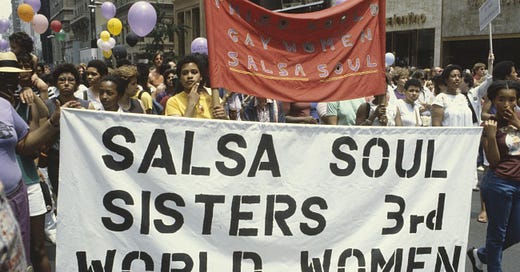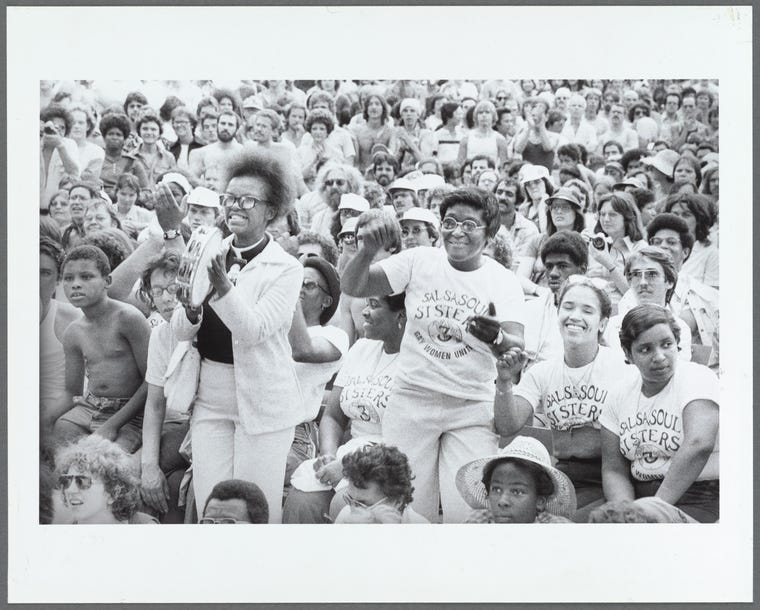Howdy, friends 👋🏻
Welcome to the new subscribers 🎉 It’s great to have you here! I hope you enjoy learning about cool women and feminist bits and bobs as much as I love telling you about them. If you’re loving this newsletter, share with a friend (or an enemy… they probably could benefit from the knowledge 😉 ).
As we close out Pride 🏳️🌈 month, I wanted to highlight something that embodies the Pride spirit. Meet the Salsa Soul Sisters!
Salsa Soul Sisters
Let’s jump in our time machine to 1974. Think Watergate, Rumble in the Jungle, disco. It was also the year Reverend Dolores Jackson founded the Salsa Soul Sisters. The Salsa Soul Sisters is the oldest Black lesbian and lesbians of color womanist organization in the United States.
Initially, the idea of the Salsa Soul Sisters started when the Black Lesbian Caucus formed within the Gay Activists Alliance. Rev. Jackson was a member of the Caucus and realized there needed to be a space where lesbians of color could discuss racism and form community. Rev. Jackson, along with Harriet Alston, Sonia Bailey, Luvenia Pinson, Candice Boyce, and Maua Flowers formed the Salsa Soul Sisters.
At the time, many LGTBQ+ women of color felt excluded in traditionally gay spaces, like gay and lesbians bars and gay rights organizations. For example, sometimes gay and lesbian bars would ask Black patrons for 2-3 forms of ID while asking white patrons for one form of ID. And that was in ATLANTA. 👀
Let’s talk name! Why Salsa Soul Sisters? They chose the name to denote their inclusiveness of Black and Latina lesbian, gay and bisexual women. They were accepting of all women of color, including Asian American and indigenous women. They began by calling themselves the Third World Gay Women’s Association but pivoted to Salsa Soul Sisters.
The Salsa Soul Sisters were quite active in the community. They held weekly meetings to discuss political and social issues in a range of locations including a church, a fire house, and a community center. They provided child care at meetings so members with children could attend meetings more easily. They attended protests, rallies, and community organizing events in New York City. They held dances, drum circles, holiday parties, and retreats. It was a safe space to express creativity, engage politically, and build community. At an anniversary event for Salsa Soul Sisters, Chirlane McCray, recounted going to her first meeting in her early 20s, sitting beside Audre Lorde who said to her, “Overwhelming, isn’t it!”
They had a newsletter called the Salsa Soul Gayzette and published their own magazine called Azalea: A Magazine by Third World Lesbians. The magazine featured poetry, fiction, letters, articles, graphics, reviews, and special features. See past issues here and here! From the magazine, they formed the Jemima Writer Collective which was the first Black lesbian writing group in New York City.
“Azalea was created partially but not totally because we feel that a lot of feminist and/or lesbian publications build walls around themselves in the same way as establishment publications do and it has been our experience that whenever standards are set in this country the people who most often set and judge them are white and thusly have not sought to include third world people.” -Joan Gibbs for Azalea Vol. 1 No. 2
The Salsa Soul Sisters identified as a womanist organization as opposed to a feminist organization. People have written entire books on the differences between these two social theories, so I can’t accurately depict the difference between them in a few sentences. But essentially (give me a grain of salt) womanism was coined by Alice Walker and is centered on the experiences of Black women and women of color with a particular focus on the intersection of gender, race and class. Historically, feminism has been seen as being led by and more aligned with white women, which in my opinion is accurate! Fight me in the comments if you disagree (seriously, let’s get into it!).
“The Sisters were so beautiful, and there were so many of them, in one room! And mind you, that wasn’t a very big room, but for me it was so much, given where I had come from. And these Sisters, they became family for me, you know? Many of them are sitting right up here, my New York family, my first New York family, and they fed my soul, they helped me see and navigate the world… We protected each other from a world that just refused to see us, let alone embrace us.” Chirlane McCray (New York Historical Society event in 2019)
In 1993, the Salsa Soul Sisters disbanded and split into two organizations: an African diaspora focused lesbian organization under the African Ancestral Lesbians United for Societal Change and Las Buenas Amigas (Good Friends) focused on the Latina experience.
If you want to get a better picture of how beautiful this group was, check out this blog from the New York Historical Society event honoring the 50 year anniversary of the Salsa Soul Sisters.
🧵Bits and Bobs🧵
For those who are new here… bits and bobs are just that! Random feminist bits and bobs I spotted in the news, on social media, or sent to me by friends. Feel free to submit anytime!
💔 Adriana Smith was taken off life support last week. This article from the Cut called “We’re Just Human Incubators To Them” is an important read about her situation and what it means for humanity more broadly.
🎨 One of my favorite Substack’s I follow is Rose Florence who writes about art history and the art world. She has a series called “Women Artists You Should Know,” which I think would be up this group’s alley! Her most recent is about abstract expressionist Mary Abbott.
Citations
https://en.wikipedia.org/wiki/Salsa_Soul_Sisters
https://en.wikipedia.org/wiki/Azalea:_A_Magazine_by_Third_World_Lesbians
https://nmaahc.si.edu/lgbtq/salsa-soul-sisters
https://www.thefeministinstitute.org/people?id=85
https://lesbianherstoryarchives.org/salsa-soul-sisters/








Love the idea in the NY Historical Society article about breaking the wall to build a bigger living room!